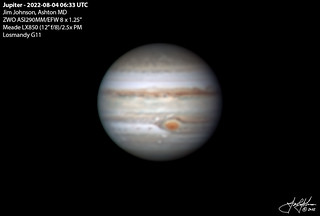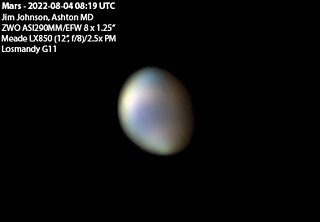On Wednesday morning I saw a very astro-friendly forecast for the evening, but I wasn’t sure if I would have an opportunity to work at the scope that night. Also, I wasn’t able to get a nap during the day, so I didn’t know if I would even feel like going out if I was otherwise able.
As it turned out, I was able to get out to the scope, and although I was very tired, I went out anyway. The Moon the whole session was huge fun with very little frustration. I had no trouble staying awake until the session ended at 0430.
Astrospheric forecasted above average transparency and seeing through midnight, and then both dropping off to average afterward. Wayne called an impromptu star party and mentioned that wildfire smoke would become an issue after midnight. I didn’t think that light smoke would be an issue for imaging planets.
The Moon
During the day I removed the ASI290 and put the ASI178 back on the scope anticipating that I would be doing lunar work first. I had made a list of eleven targets that I wanted to shoot, and memorized where they were while I was waiting for it to get dark. Stellarium showed me that I had about half an hour between the time that it got dark enough to start imaging at 2150 until the Moon began to creep over the cottage roof at about 2115. The night prior, the moon was lower, and it was already over the cottage roof before I could start shooting, so already this was shaping up to be a good night. I had also read about some performance updates to Firecapture that I was hoping would yield frame rates better than the 30 – 40 fps that I was getting the night prior.
I set my limit to 4000 frames and I started my first capture at 2048. I was seeing frame rates of around 100 for full frame captures, and up to about 200 fps for smaller ROIs. With these frame rates I was able to work through my list pretty quicky, and I may have ran two or three additional unplanned captures. I was finished capturing by 2113. I captured 150 Gb of data in that short time!
I was a little rusty on Tuesday night, and much smoother tonight. It felt good to be able to knock the rust off that quickly. I hope that I am as lucky when I start shooting the planets.
The temperature was about 73 degrees. There was the slightest occasional breeze, and everything was still dry when I cam in from that part of the session. Transparency seemed inline with the forecast, and seeing was definitely better than the previous night.
The Planets
As I finished the lunar session, took the ASI178 off of the Meade and put the ASI290 back on the telescope. I also made sure that camera and filter wheel connected to the computer, and I verified that the filter wheel was actually turning in response to me pressing the Skittles. I also made sure that I remembered how to set up filters for RGB autoruns. I am glad that I did bang that bit of rust off before I was ready to start imaging.
My plan was to shoot everything as soon as it became available. Saturn would be out of the trees first, and very close to the meridian at 0115. Jupiter would be next at 0210. It would be a couple of hours before the meridian, but the GRS would be more favorably positioned at the tree line. And Mars brings up the rear at about 0400. It is very highly elevated, but it would be 8” in apparent diameter. I didn’t know if I would be able to make it that long.
Getting Saturn onto the display took a little work because I was rusty at this process – maybe 10 minutes to relearn. It only took me a couple of minutes to dial in a good gain/exp combination for each of the RGB filters. After doing a manually advancing through the filters for a 30s run on each, I turn on Use RGB and let FC automatically run through the filters. That worked great, so I opened up Autorun, and set that up for maybe three runs. And finally I went to L and did a massively over exposed 30s run to see which satellites I could pick up. As was my practice last year, I manually guided. After truing my polar alignment up the night before, was able to stay within a reasonably small ROI box with little difficulty. Total capture on Saturn was 14 Gb.
Just as I finished on Saturn, Jupiter was about to come out of the trees. I slewed to it and was able to wrangle it onto the display in just a couple of seconds. I did a couples of Autoruns – 3, 5, and 10 – using variously sized ROI boxes. I was getting about 100fps at one point. I also did a run with Europa and Io in the frame. I finished up by doing a massively overexposed 30s run to see if I can pull out any other satellites. Total capture on Jupiter was 110 Gb.
After an hour’s break, I went back out to meet Mars as it came out of the trees. Just like with Jupiter, I was able to get Mars onto the display within a couple of seconds. The seeing seemed much worse while shooting Mars than it did for Saturn and Jupiter. This could have been an actual deterioration in seeing, or it could have been because was zoomed in on a much smaller ROI box. I manually walked through each of the RGB filters, then I used Autorun for three sets of RGB. After that I did an Autorun for three sets of iRGB. And finally, I did an over exposed run to see if I could pick out any satellites. I was seeing 500+ fps in R and iR, and 2-300 fps in G and B. I captured 10 Gb on Mars.
The temperature had actually warmed up a little from the time that I had went out to work on the moon. There was light dew on a few things, but my front glass stayed clear with a low dew controller setting.
General
While dust plagues me no worse than any other astronomer, I find it frustrating that no matter how carefully that I clean optics, there is always dust that shows up in my images. I may have stumbled onto something. I shined my headlamp down the front of my telescope so that I could see the filters cycle through the field of view whenever I pressed a Skittle. With the bright light shining down the front of the telescope, I could see every speck of dust in the universe on the display. So, I am going to try checking my optics with a flashlight and a telescope the next time that I clean optics.
The session on the planets went so well that I am inclined so see if I can my Firecapture’s autoguiding work for me. Also regarding the planets, with Mars being so small, and with seeing being so good while shooting the planets, the 5x PowerMate sounds like something to think about.
I left the dew shield off and used just a dew strap on the front of the scope so that I could check collimation. I completely forgot to do the collimation check.
Total capture for the session was about 285 Gb!





